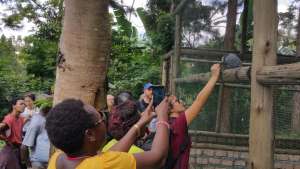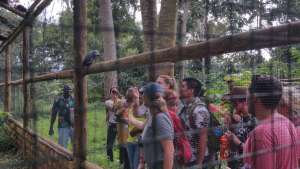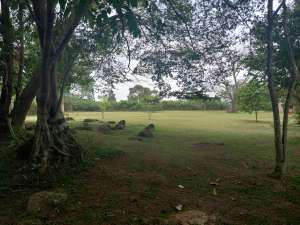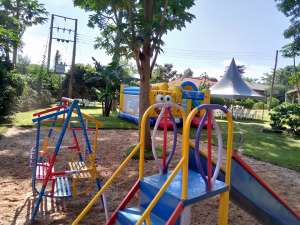 A zoo is a place where animals live on fences and are put on display for people to view. The word “zoo” is short for “zoological park.” Zoos are places where wild animals are kept for public display. Zoos are often the sites of sophisticated breeding centres, where endangered species may be protected and studied.
A zoo is a place where animals live on fences and are put on display for people to view. The word “zoo” is short for “zoological park.” Zoos are places where wild animals are kept for public display. Zoos are often the sites of sophisticated breeding centres, where endangered species may be protected and studied.
Today, CETC is meant to entertain and educate the public but has a strong emphasis on scientific research and species conservation. There is a trend toward giving animals more space and recreating natural habitats. CETC is regulated and inspected by the government of Uganda under Uganda Wildlife Authority.
- Hands-On Experiences
- Play Areas
- Educational Programs
- Kid-Friendly Technology
- After-Visit Activities
- Fun Shade Structures
What Is Nakoosi’s Zoo Experience?
A CETC visitors’ primary goal for a zoo experience is fun and entertainment. While fun and entertainment are significant aspects of the CETC Nakoosi zoo experience, the heart and soul of a CETC Nakoosi zoo include conservation, education, and research. Making these aspects fun and entertaining and incorporating them into your visitor experience can create a memorable trip for all ages.
Conservation at CETC Nakoosi Zoo
 CETC Nakoosi Zoo has evolved from purely recreational to being a leader in animal conservation efforts in Uganda. Conservation has become an important part of the mission statements of these modern CETC Nakoosi zoos. If this zoo is involved in conservation efforts, it likely is involved in two ways:
CETC Nakoosi Zoo has evolved from purely recreational to being a leader in animal conservation efforts in Uganda. Conservation has become an important part of the mission statements of these modern CETC Nakoosi zoos. If this zoo is involved in conservation efforts, it likely is involved in two ways:
- Practising conservation: Conservation practices may include species survival plans, captive breeding, and species reintroduction programs. The CETC Nakoosi zoo will also use revenue or donations for conservation programs in the wild and the Nakoosi Community groups.
- Advocating for conservation: Conservation advocacy involves promoting awareness, public engagement, and fundraising. When visitors can contribute to and be part of conservation efforts as part of their zoo experience, it makes them feel like they’re part of something big.
Many zoo visitors are more inclined to participate in conservation efforts while they’re at the CETC Nakoosi zoo instead of before or after their visit because they can see the animals firsthand. Offering opportunities for visitors to participate in conservation efforts is an effective way to enhance their zoo experience.
Education
Educating visitors is also part of CETC Nakoosi zoos’ mission statement. Each year, CETC Nakoosi zoo has the opportunity to educate over 2000 visitors worldwide. Visitors can learn about wild animals and their habitats, conservation issues, how they can contribute to preserving endangered species, and how the zoo is helping. Informational signs, presentations, interactive programs, and demonstrations are exciting ways for visitors to learn while having fun at the CETC Nakoosi zoo.
Making learning fun, especially for kids, is an effective way to make the information memorable and retainable. When you inspire your visitors through the information you present, they’ll enjoy their visit and may want to participate in conservation efforts.
Research
Research is an integral part of understanding the animals in a CETC Nakoosi zoo’s care. The Association of CETC Nakoosi Zoo and Community groups believes that animal care, management, and conservation should be based on science. In 2017, UWA-accredited CETC Nakoosi zoo spends about a lot of millions on research efforts that can be used to enhance the scientific knowledge of animals and engage zoo visitors. Through this research, CETC Nakoosi zoo can create better experiences for visitors and animals alike.
The Challenges CETC Nakoosi Zoo’s Face
One of the most prevalent challenges CETC Nakoosi Zoo face is a lack of adequate space for captive animals. CETC Nakoosi Zoo may receive criticism from animal-rights advocates about restrictive enclosures and unnatural habitats. Guidelines for animal enclosures that are consistently updated have forced CETC Nakoosi zoo across the CETC to close specific exhibits and, in some cases, the whole zoo. Without the money or space to expand enclosures to meet CETC Nakoosi guidelines, it’s likely that CETC Nakoosi will continue to close or become more amusement park-based.
Ethical concerns voiced by animal-rights advocates have become coupled with safety concerns — for visitors, staff, and animals. Despite these challenges, CETC Nakoosi zoo will continue to offer wildlife experiences that the public wouldn’t have access to otherwise. For many people, CETC Nakoosi zoo is the only way to see exotic and wild animals. Creating a memorable zoo visitor experience is essential in keeping people coming back to explore more.
Top Ways to Enhance the Visitor Experience at CETC Nakoosi Zoo
It’s important to engage visitors in a way that makes them want to return to your zoo. When visitors enjoy their experience, they’re more likely to become repeat visitors and recommend your zoo to others. Learn how to improve the CETC Nakoosi zoo visitor experience through animal shows, increased interaction, mobile technology, shade structures, and more.
1. Animal Shows and Displays
 Animal shows are a fan favourite. Visitors have the chance to see CETC Nakoosi zoo staff interact with animals during feeding times, playtimes, and shows designated for the audience’s enjoyment. It’s common for showtimes to be one of the only chances for visitors to see CETC Nakoosi zoo animals being active. Incorporating a variety of shows with different animals gives patrons a better chance to see their favourite animals up and about.
Animal shows are a fan favourite. Visitors have the chance to see CETC Nakoosi zoo staff interact with animals during feeding times, playtimes, and shows designated for the audience’s enjoyment. It’s common for showtimes to be one of the only chances for visitors to see CETC Nakoosi zoo animals being active. Incorporating a variety of shows with different animals gives patrons a better chance to see their favourite animals up and about.
The opportunity to touch or feed a wild animal is sure to thrill visitors of all ages. Increasing the opportunity for hands-on interactions with animals can make for an unforgettable trip to the zoo. Create staff-monitored displays that allow guests to interact with their favourite mammals or reptiles directly. Even an event that’s as simple as showing off a unique critter from a faraway place enables zoo patrons to get up-close and personal with the animals.
2. Human-Animal Connections
 As a way to increase enclosure sizes and create stronger connections between visitors and animals, CETC Nakoosi zoo has begun to develop exhibits that make visitors part of the exhibit. Breaking down the barriers between humans and animals makes the experience more interactive without the two directly interacting with each other. For example, at the CETC Nakoosi Zoo in Namuyenje, Mukono, Uganda visitors can watch and view birds and primates freely-roaming Ostriches in a five-over 30 acres exhibit.
As a way to increase enclosure sizes and create stronger connections between visitors and animals, CETC Nakoosi zoo has begun to develop exhibits that make visitors part of the exhibit. Breaking down the barriers between humans and animals makes the experience more interactive without the two directly interacting with each other. For example, at the CETC Nakoosi Zoo in Namuyenje, Mukono, Uganda visitors can watch and view birds and primates freely-roaming Ostriches in a five-over 30 acres exhibit.
CETC Nakoosi zoo has created similar experiences in the form of safari camping that takes visitors out into fields full of roaming wildlife and plants. In 2011, the CETC Nakoosi Zoo in Nakoosi, Namuyenje, Mukono began opening Zoo exhibits that feature animal exploration and plant trails. Since then, the zoo has expanded the project, and the mesh trails provide zoo animals with the ability to roam above and around the zoo grounds. This unique type of exhibit gives the animals more space to roam and makes zoo visitors feel like they’re part of the exhibit.
These types of exhibits create positive experiences for humans because they’re unique opportunities and for the animals because it gives them more space to roam.
3. Conservation Efforts Education
As mentioned before, conservation is a big part of CETC Nakoosi zoo’s mission statement. In addition to this, it’s important to encourage visitors to participate in conservation efforts. How can you achieve this? Educating your visitors is an excellent place to start. Creating awareness of the animals that are already endangered or are reaching endangerment and how organizations are helping them can encourage visitors to make donations or follow the effort.
Demonstrating care and respect for the animals in our facility is another effective way to encourage conservation efforts. When it’s clear that a zoo has taken the time to consider an animal’s needs for food as well as intellectual stimulation and socialization, it reminds visitors that animals have these needs. Realizing that animals have needs that are similar to humans can create empathy and concern for the animals, which helps your visitors feel a connection with them. This connection can also help encourage the desire to contribute to conservation efforts.
5. Shade Structures
 On a hot sunny day, humans and animals alike will be searching for shaded areas for relief from the sun. Although it may not be something that immediately comes to mind when brainstorming CETC Nakoosi zoo improvement ideas, shade structures are a comforting, unique way to show visitors you care about their well-being. Providing adequate shaded space for zoo guests will enhance their experience because they’ll have areas to rest and cool off before continuing their adventure.
On a hot sunny day, humans and animals alike will be searching for shaded areas for relief from the sun. Although it may not be something that immediately comes to mind when brainstorming CETC Nakoosi zoo improvement ideas, shade structures are a comforting, unique way to show visitors you care about their well-being. Providing adequate shaded space for zoo guests will enhance their experience because they’ll have areas to rest and cool off before continuing their adventure.
Shade structures also offer a way to design exhibits and attractions that will be visually appealing to visitors. Dining areas or shuttle stops with a canopy overhead allow visitors to enjoy the fresh air of an outdoor space while protected from the sun. It is also worth considering adding shade structures to the areas surrounding animal exhibits to allow patrons to appreciate the wildlife without having to rush out of the sun on a hot day.
Top Ways to Enhance the Zoo Experience for Kids
 The Chakig Eco-tourism Centre Nakoosi zoo is a popular attraction for children of all ages. As fun as seeing their favourite animals can be, how can you make their experience even better? Children need a bit more entertainment than adults, so adding hands-on experiences tailored to their age group, play areas, and opportunities to digitally interact with animals can help enhance the zoo experience for kids.
The Chakig Eco-tourism Centre Nakoosi zoo is a popular attraction for children of all ages. As fun as seeing their favourite animals can be, how can you make their experience even better? Children need a bit more entertainment than adults, so adding hands-on experiences tailored to their age group, play areas, and opportunities to digitally interact with animals can help enhance the zoo experience for kids.
1. Hands-On Experiences
Kids learn and benefit from hands-on experiences. Being able to touch and experience animals up close can inspire kids to want to learn more, which aligns with the value of education in zoos. Petting zoo areas are a good way to allow children to freely explore friendly animals. Allowing kids to participate in shows or feeding opportunities is another great way to give your younger audience a memorable hands-on zoo experience.
2. Play Areas
 Play areas are an effective way for kids to release energy and have fun. Animal-themed playgrounds and activity areas offer a fun way for kids to take a break and explore their wild side. Playgrounds designed to enrich the zoo experience will encourage kids to explore and discover more as they continue to learn about animals and the environments they come from.
Play areas are an effective way for kids to release energy and have fun. Animal-themed playgrounds and activity areas offer a fun way for kids to take a break and explore their wild side. Playgrounds designed to enrich the zoo experience will encourage kids to explore and discover more as they continue to learn about animals and the environments they come from.
In addition to themed playgrounds, activity areas can be beneficial for kids. A themed craft hour or interactive presentation allows staff members to tell exciting animal stories and engage with kids while providing an exciting learning moment. Give the kids something small to take home, like the craft they made or perhaps a cool bird feather, so they can remember their experience and the information they learned.
3. Educational Programs
Educational programs can include day camps and presentations that provide a valuable learning opportunity. These programs can help children increase their awareness of animal care, behaviour, and conservation. The staff may also share stories about what it’s like to care for these animals in captivity versus what they’re like in the wild.
Create activities and content that allows kids to absorb information using senses like touch and smell to make their experience special. These programs can be a fun, structured way to instil animal knowledge in your young visitors’ minds.
5. After-Visit Activities
Kids will likely talk about their zoo trip for weeks after. Take advantage of their interest by making use of your mobile app so your young visitors can enjoy activities even after they leave Chakig Eco-tourism Centre Nakoozi zoo. In-app games and activities for continued learning can keep kids interested in wildlife long after they leave the gates of our facility. Encouraging their exploration and interest in wild animals is a great way to inspire a return visit and the desire to participate in conservation efforts.
6. Fun Shade Structures
Shade structures can enhance the zoo experience for kids as well! While playgrounds are fun and exciting for energetic children, the sun can make the playground equipment hot and uncomfortable on a summer day. Shade structures built over play areas can help shade the equipment from the sun to offer a colourful solution so kids can continue their carefree fun.
Benefits of Adding Shade Structures to Zoos
 Shade is an important element at any zoo. Both animals and humans can benefit from the shade on a sunny day. Shade structures allow you to add shade to any environment, especially where there may be a limited number of trees or overhangs. There are many benefits to adding shade structures to Chakig Eco-tourism Centre Nakoosi zoo, some of which include:
Shade is an important element at any zoo. Both animals and humans can benefit from the shade on a sunny day. Shade structures allow you to add shade to any environment, especially where there may be a limited number of trees or overhangs. There are many benefits to adding shade structures to Chakig Eco-tourism Centre Nakoosi zoo, some of which include:
- Improve visitor experience: Shade structures create shaded spaces for a more comfortable and cool area to relax. When your visitors are more comfortable while exploring, they’ll be able to focus more on the animals they came to see rather than how hot and sweaty they feel. Add shade structures to walkways, animal viewing areas and over benches or tables to create a more enjoyable space.
- Add shade over animal exhibits: In addition to making your visitors more comfortable, shade structures can be used to make your animals more comfortable, too. Shading an otter’s pool can keep the water at a lower temperature, and adding a shade structure to an exhibit offers them a cool place to hang out when they need a break from the sun.
- Add shade over playgrounds: Adding shade structures in and around play areas is an effective way to provide shade for the kids playing and add to the theme of the playground. Create a fun and exciting play area with colourful shade structures while also shading children from harmful UV rays. At UChakig Eco-tourism Centre Nakoosi, we offer flower and butterfly-shaped shade structures to add a unique touch to your play areas.
- Offer design appeal: Well-designed exhibits can influence visitor perceptions of the animals and your zoo as a whole, so use shade structures to help with exhibit design. Natural colours and canopy designs can create an organic appearance that appeals to your visitors and animals. Shade structures can be used to create uniquely designed shaded spaces that give your zoo a feature to “wow” your visitors with.
